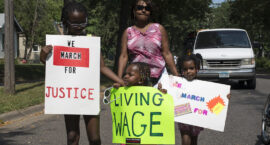A new guaranteed income program will send $850 monthly payments to Black women over two years, beginning in Atlanta’s Old Fourth Ward, where King popularized the idea of direct cash payments half a century ago.
“Oftentimes our communities are viewed as lacking knowledge, lacking resources, lacking assets. We want to flip that narrative. Communities closest to the problem are rich with resources and insight on how to solve our deepest social issues, our deepest economic issues,” said Hope Wollensack, executive director of the Georgia Resilience and Opportunity Fund. “We want to put agency over one’s future in [women’s] hands.”



















